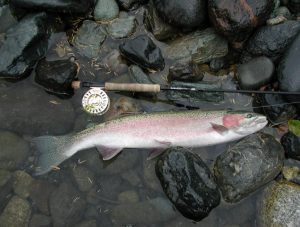 When it comes to fly fishing for salmon, it is necessary to have a good knowledge of the behaviors of the fish if you want to enjoy success.
When it comes to fly fishing for salmon, it is necessary to have a good knowledge of the behaviors of the fish if you want to enjoy success.
Salmon behave very differently in the ocean and in fresh water, and although land locked salmon have similar eating habits to their traveling cousins, they will often bite on more varied salmon fishing flies than spawners up from the ocean or ocean dwelling salmon.
The first thing to remember is that as a general rule, terrestrials are out when it comes to salmon fishing. Salmon don’t usually care about what is going on above their heads in the air, and they are therefore not too likely to bite on a fly impersonating a drowning ant, fly, or bee.
It is important not to get terrestrials confused with dry flies in this case; while terrestrials won’t work because they are designed to look like a specific species, ambiguously shaped dry flies often lead to success. Both steelhead and Atlantic salmon are very aggressive during the spawn, and are prone to striking anything that irritates them in order to protect their chosen spot. Oddly shaped dry flies can be just provocative enough to infuriate a steelhead and get it to rise.
Another common tactic among fly fishing to strike from your plan if you are looking to catch salmon is having fly assortments. Salmon are moody both in salt and fresh water, and they think as a group. If one fly is working, it is going to work on all the fish. If a fly is not working, it is unlikely that any fly will work. Instead of having fly assortments, just bring one or two specific flies in fresh water, and only your favorite fly for salt.
Streamers are wet flies that are pretty successful in all salmon environments. Salmon that aren’t spawning will cruise the tide lines looking for schools of herring, so a good streamer that impersonates a wounded baitfish can get you a lot of strikes in a short period of time.
Almost any type of streamer will do, depending on your skill in working it on the line. Salt water flies that imitate herring are the most successful, as this is the salmon’s main prey out in the ocean. When salmon are spawning, streamers can be a great way to get a protective strike from a salmon guarding its area. Streamers that work best here are those which represent local fish species.
Nymphs really only work well when fishing for kokanee and only in very specific situations. Kokanee will bite on nymphs in the spring, when the natural larvae are making their way to the surface. The best set up is a sinking nymph on a floating line; this will emulate the natural behavior enough to entice a kokanee to bite.
Fly fishing for salmon requires a lot of patience, skill, and luck. Salmon species are among the most prized catches among fly fishermen, not only because of the fight they put up on the line but also because of how hard it is to get them to bite in the first place (especially in fresh water, even in the case of kokanee). Using the right type of salmon fishing fly for the trip can mean you earn some very credible bragging rights.
